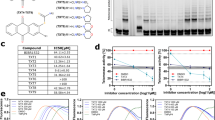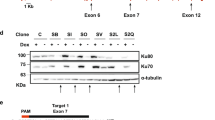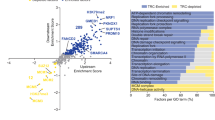Abstract
The INO80 (inositol requiring mutant 80) chromatin remodeling complex plays important roles in transcriptional regulation and DNA replication and repair, and consists of several functional protein subunits, including the critical Ino80 ATPase catalytic subunit. While the function of INO80 has been studied in yeast and mammalian cell lines, we do not know how mIno80 contributes to the maintenance of genome stability to prevent cancer development in mice. Here, we use a conditional knockout approach to explore the cellular and organismal functions of mIno80. Deletion of mIno80 results in profound cellular proliferative defects and activation of p21-dependent cellular senescence. While mIno80 is required for efficient repair of DNA double strand breaks, its depletion did not impact upon the formation of γ-H2AX and 53BP1 DNA damage foci, or the activation of the ATM-CHK2-dependent DNA damage response. mIno80 deletion inhibited the generation of single-strand DNA, resulting in defects in homology-directed DNA repair (HDR) at telomeres. Fragile telomeres were prominent in mIno80Δ/Δ MEFs, suggesting that chromatin remodeling is required for efficient telomere replication. mIno80−/− mouse embryos die early during embryogenesis, while conditional deletion of mIno80 in adult mice results in weight loss and premature death. In a p53−/− tumor-prone background, mIno80 haploinsufficiency favored the development of sarcomas. Our studies suggest that the mIno80 chromatin remodeling complex plays important roles in telomere replication, HDR-mediated repair of dysfunctional telomeres, and maintenance of genome stability.
Similar content being viewed by others
Log in or create a free account to read this content
Gain free access to this article, as well as selected content from this journal and more on nature.com
or
References
Watanabe S, Peterson CL . The INO80 family of chromatin-remodeling enzymes: regulators of histone variant dynamics. Cold Spring Harb Symp Quant Biol 2010; 75:35–42.
Shimada K, Oma Y, Schleker T, et al. Ino80 chromatin remodeling complex promotes recovery of stalled replication forks. Curr Biol 2008; 18:566–575.
Trujillo KM, Osley MA . INO80 meets a fork in the road. Nat Struct Mol Biol 2008; 15:332–334.
Vincent JA, Kwong TJ, Tsukiyama T . ATP-dependent chromatin remodeling shapes the DNA replication landscape. Nat Struct Mol Biol 2008; 15:477–484.
Morrison AJ, Shen X . Chromatin remodelling beyond transcription: the INO80 and SWR1 complexes. Nat Rev Mol Cell Biol 2009; 10:373–384.
Seeber A, Hauer M, Gasser SM . Nucleosome remodelers in double-strand break repair. Curr Opin Genet Dev 2013; 23:174–184.
Jin J, Cai Y, Yao T, et al. A mammalian chromatin remodeling complex with similarities to the yeast INO80 complex. J Biol Chem 2005; 280:41207–41212.
Conaway RC, Conaway JW . The INO80 chromatin remodeling complex in transcription, replication and repair. Trends Biochem Sci 2009; 34:71–77.
Papin C, Humbert O, Kalashnikova A, et al. 3′- to 5′ DNA unwinding by TIP49b proteins. FEBS J 2010; 277:2705–2714.
Yu EY, Steinberg-Neifach O, Dandjinou AT, et al. Regulation of telomere structure and functions by subunits of the INO80 chromatin remodeling complex. Mol Cell Biol 2007; 27:5639–5649.
O'Sullivan RJ, Karlseder J . Telomeres: protecting chromosomes against genome instability. Nat Rev Mol Cell Biol 2010; 11:171–181.
Baumann P, Cech TR . Pot1, the putative telomere end-binding protein in fission yeast and humans. Science 2001; 292:1171–1175.
Wu L, Multani AS, He H, et al. Pot1 deficiency initiates DNA damage checkpoint activation and aberrant homologous recombination at telomeres. Cell 2006; 126:49–62.
He H, Multani AS, Cosme-Blanco W, et al. POT1b protects telomeres from end-to-end chromosomal fusions and aberrant homologous recombination. EMBO J 2006; 25:5180–5190.
Chan SS, Chang S . Defending the end zone: studying the players involved in protecting chromosome ends. FEBS Letters 2010; 584:3773–3778.
Guo X, Deng Y, Lin Y, et al. Dysfunctional telomeres activate an ATM-ATR-dependent DNA damage response to suppress tumorigenesis. EMBO J 2007; 26:4709–4719.
Deng Y, Guo X, Ferguson DO, Chang S . Multiple roles for MRE11 at uncapped telomeres. Nature 2009; 460:914–918.
Denchi EL, de Lange T . Protection of telomeres through independent control of ATM and ATR by TRF2 and POT1. Nature 2007; 448:1068–1071.
Hu Y, Tang H-B, Liu N-N, et al. Telomerase-null survivor screening identifies novel telomere recombination regulators. PLoS Genet 2013; 9:e 1003208.
Wu S, Shi Y, Mulligan P, et al. A YY1-INO80 complex regulates genomic stability through homologous recombination-based repair. Nat Struct Mol Biol 2007; 14:1165–1172.
Park EJ, Hur SK, Kwon J . Human INO80 chromatin-remodelling complex contributes to DNA double-strand break repair via the expression of Rad54B and XRCC3 genes. Biochem J 2011; 431:179–187.
Hur SK, Park EJ, Han JE, et al. Roles of human INO80 chromatin remodeling enzyme in DNA replication and chromosome segregation suppress genome instability. Cell Mol Life Sci 2010; 67:2283–2296.
Gospodinov A, Vaissiere T, Krastev DB, Legube G, Anachkova B, Herceg Z . Mammalian Ino80 mediates double-strand break repair through its role in DNA end strand resection. Mol Cell Biol 2011; 31:4735–4745.
Kitayama K, Kamo M, Oma Y, et al. The human actin-related protein hArp5: Nucleo-cytoplasmic shuttling and involvement in DNA repair. Exp Cell Res 2009; 315:206–217.
Hayashi S, McMahon AP . Efficient recombination in diverse tissues by a tamoxifen-inducible form of Cre: a tool for temporally regulated gene activation/inactivation in the mouse. Dev Biol 2002; 244:305–318.
Morrison AJ, Highland J, Krogan NJ, et al. INO80 and gamma-H2AX interaction links ATP-dependent chromatin remodeling to DNA damage repair. Cell 2004; 119:767–775.
van Attikum H, Fritsch O, Hohn B, Gasser SM . Recruitment of the INO80 complex by H2A phosphorylation links ATP-dependent chromatin remodeling with DNA double-strand break repair. Cell 2004; 119:777–788.
Sancar A . DNA excision repair. Ann Rev Biochem 1996; 65:43–81.
Jiang Y, Wang X, Bao S, et al. INO80 chromatin remodeling complex promotes the removal of UV lesions by the nucleotide excision repair pathway. Proc Natl Acad Sci USA 2010; 107:17274–17279.
Papamichos-Chronakis M, Peterson CL . The Ino80 chromatin-remodeling enzyme regulates replisome function and stability. Nat Struct Mol Biol 2008; 15:338–345.
Falbo KB, Alabert C, Katou Y, et al. Involvement of a chromatin remodeling complex in damage tolerance during DNA replication. Nat Struct Mol Biol 2009; 16:1167–1172.
Mimitou EP, Symington LS . Nucleases and helicases take center stage in homologous recombination. Trends Biochem Sci 2009; 34:264–272.
Chen X, Cui D, Papusha A, et al. The Fun30 nucleosome remodeller promotes resection of DNA double-strand break ends. Nature 2012; 489:576–580.
Raderschall E, Golub EI, Haaf T . Nuclear foci of mammalian recombination proteins are located at single-stranded DNA regions formed after DNA damage. Proc Natl Acad Sci USA 1999; 96:1921–1926.
Sartori AA, Lukas C, Coates J, et al. Human CtIP promotes DNA end resection. Nature 2007; 450:509–514.
Shao R-G, Cao C-X, Zhang H, Kohn KW, Wold MS, Pommier Y . Replication-mediated DNA damage by camptothecin induces phosphorylation of RPA by DNA-dependent protein kinase and dissociates RPA:DNA-PK complexes. EMBO J 1999; 18:1397–1406.
Liu S, Opiyo SO, Manthey K, et al. Distinct roles for DNA-PK, ATM and ATR in RPA phosphorylation and checkpoint activation in response to replication stress. Nucleic Acids Res 2012; 40:10780–10794.
Casper AM, Nghiem P, Arlt MF, Glover TW . ATR regulates fragile site stability. Cell 2002; 111:779–789.
Arlt MF, Xu B, Durkin SG, Casper AM, Kastan MB, Glover TW . BRCA1 is required for common-fragile-site stability via its G2/M checkpoint function. Mol Cell Biol 2004; 24:6701–6709.
Sfeir A, Kosiyatrakul ST, Hockemeyer D, et al. Mammalian telomeres resemble fragile sites and require TRF1 for efficient replication. Cell 2009; 138:90–103.
Gu P, Min JN, Wang Y, et al. CTC1 deletion results in defective telomere replication, leading to catastrophic telomere loss and stem cell exhaustion. EMBO J 2012; 16:2309–2321.
Yunis JJ, Soreng AL . Constitutive fragile sites and cancer. Science 1984; 226:1199–1204.
Liu D, O'Connor MS, Qin J, Songyang Z . Telosome, a mammalian telomere-associated complex formed by multiple telomeric proteins. J Biol Chem 2004; 279:51338–51342.
Rai R, Zheng H, He H, et al. The function of classical and alternative non-homologous end-joining pathways in the fusion of dysfunctional telomeres. EMBO J 2010; 29:2598–2610.
Dimitrova N, Chen Y-CM, Spector DL, de Lange T . 53BP1 promotes non-homologous end joining of telomeres by increasing chromatin mobility. Nature 2008; 456:524–528.
Bailey SM, Brenneman MA, Goodwin EH . Frequent recombination in telomeric DNA may extend the proliferative life of telomerase-negative cells. Nucleic Acids Res 2004; 32:3743–3751.
Papamichos-Chronakis M, Watanabe S, Rando OJ, Peterson CL . Global regulation of H2A.Z localization by the INO80 chromatin-remodeling enzyme is essential for genome integrity. Cell 2011; 144:200–213.
Chambers AL, Ormerod G, Durley SC, et al. The INO80 chromatin remodeling complex prevents polyploidy and maintains normal chromatin structure at centromeres. Genes Dev 2012; 26:2590–2603.
Barneoud P, Lolivier J, Sanger DJ, Scatton B, Moser P . Quantitative motor assessment in FALS mice: a longitudinal study. Neuroreport 1997; 8:2861–2865.
Weydt P, Hong SY, Kliot M, Moller T . Assessing disease onset and progression in the SOD1 mouse model of ALS. Neuroreport 2003; 14:1051–1054.
Wang GG, Allis CD, Chi P . Chromatin remodeling and cancer, Part II: ATP-dependent chromatin remodeling. Trends Mol Med 2007; 13:373–380.
Versteege I, Sevenet N, Lange J, et al. Truncating mutations of hSNF5/INI1 in aggressive paediatric cancer. Nature 1998; 394:203–206.
Klochendler-Yeivin A, Picarsky E, Yaniv M . Increased DNA damage sensitivity and apoptosis in cells lacking the Snf5/Ini1 subunit of the SWI/SNF chromatin remodeling complex. Mol Cell Biol 2006; 26:2661–2674.
Isakoff MS, Sansam CG, Tamayo P, et al. Inactivation of the Snf5 tumor suppressor stimulates cell cycle progression and cooperates with p53 loss in oncogenic transformation. Proc Natl Acad Sci USA 2005; 102:17745–17750.
Gao Y, Ferguson DO, Xie W, et al. Interplay of p53 and DNA-repair protein XRCC4 in tumorigenesis, genomic stability and development. Nature 2000; 404:897–900.
Jacks T, Remington L, Williams BO, et al. Tumor spectrum analysis in p53-mutant mice. Curr Biol 1994; 4:1–7.
Downs JA, Allard Sp, Jobin-Robitaille O, et al. Binding of chromatin-modifying activities to phosphorylated histone H2A at DNA damage sites. Mol Cell 2004; 16:979–990.
Papamichos-Chronakis M, Krebs JE, Peterson CL . Interplay between Ino80 and Swr1 chromatin remodeling enzymes regulates cell cycle checkpoint adaptation in response to DNA damage. Genes Dev 2006; 20:2437–2449.
Kashiwaba S, Kitahashi K, Watanabe T, Onoda F, Ohtsu M, Murakami Y . The mammalian INO80 complex is recruited to DNA damage sites in an ARP8 dependent manner. Biochem Biophys Res Commun 2010; 402:619–625.
Flynn RL, Centore RC, O/'Sullivan RJ, et al. TERRA and hnRNPA1 orchestrate an RPA-to-POT1 switch on telomeric single-stranded DNA. Nature 2011; 471:532–536.
van Attikum H, Fritsch O, Gasser SM . Distinct roles for SWR1 and INO80 chromatin remodeling complexes at chromosomal double-strand breaks. EMBO J 2007; 26:4113–4125.
He H, Wang Y, Guo X, et al. Pot1b deletion and telomerase haploinsufficiency in mice initiate an ATR-dependent DNA damage response and elicit phenotypes resembling dyskeratosis congenita. Mol Cell Biol 2009; 29:229–240.
Li Z, Gadue P, Chen K, et al. Foxa2 and H2A.Z mediate nucleosome depletion during embryonic stem cell differentiation. Cell 2012; 151:1608–1616.
Buonomo SBC, Wu Y, Ferguson D, de Lange T . Mammalian Rif1 contributes to replication stress survival and homology-directed repair. J Cell Biol 2009; 187:385–398.
Groth A, Corpet A, Cook AJ, et al. Regulation of replication fork progression through histone supply and demand. Science 2007; 318:1928–1931.
Rai R, Li JM, Zheng H, et al. The E3 ubiquitin ligase Rnf8 stabilizes Tpp1 to promote telomere end protection. Nat Struct Mol Biol 2011; 18:1400–1407.
Acknowledgements
This work was supported by funding from NCI (RO1 CA129037 to SC; CA127945 and CA097175 Project 3 to LL).
Author information
Authors and Affiliations
Corresponding author
Additional information
( Supplementary information is linked to the online version of the paper on the Cell Research website.)
Supplementary information
Supplementary information, Figure S1
Deletion of mouse mIno80 gene. (PDF 452 kb)
Supplementary information, Figure S2
DNA damage foci are present in mIno80 deleted cells. (PDF 704 kb)
Supplementary information, Figure S3
(A) Representative colony forming assays of 4-HT treated CAG-CreER; mIno80+/+ and CAG-CreER; mIno80F/F MEFs following exposure to 0.2μM aphidicolin (APH) or 0.05mM hydroxyurea for 24hrs. (PDF 3242 kb)
Supplementary information, Figure S4
mIno80 deletion did not alter total telomere length, G-overhang status, and recruitment 53BP1 to dysfunctional telomeres. (PDF 1349 kb)
Supplementary information, Figure S5
mIno80 deletion does not impact upon C-NHEJ or A-NHEJ mediated DNA repair. (PDF 1548 kb)
Supplementary information, Figure S6
Phenotype of mIno80 heterozygote mice. (PDF 3742 kb)
Rights and permissions
About this article
Cite this article
Min, JN., Tian, Y., Xiao, Y. et al. The mINO80 chromatin remodeling complex is required for efficient telomere replication and maintenance of genome stability. Cell Res 23, 1396–1413 (2013). https://doi.org/10.1038/cr.2013.113
Received:
Revised:
Accepted:
Published:
Issue date:
DOI: https://doi.org/10.1038/cr.2013.113
Keywords
This article is cited by
-
INO80 is required for oncogenic transcription and tumor growth in non-small cell lung cancer
Oncogene (2017)
-
Epigenetic regulation in cell senescence
Journal of Molecular Medicine (2017)
-
Ino80 is essential for proximal-distal axis asymmetry in part by regulating Bmp4 expression
BMC Biology (2016)
-
Epigenomic regulation of oncogenesis by chromatin remodeling
Oncogene (2016)
-
Systematic characterization of deubiquitylating enzymes for roles in maintaining genome integrity
Nature Cell Biology (2014)



